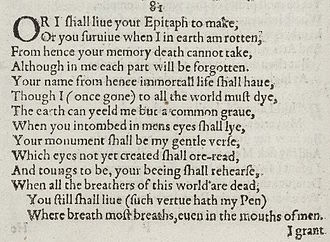Poem by William Shakespeare
| «» Sonnet 81 | |||||||
|---|---|---|---|---|---|---|---|
 Sonnet 81 in the 1609 Quarto Sonnet 81 in the 1609 Quarto | |||||||
| |||||||
Sonnet 81 is one of 154 sonnets written by William Shakespeare, and published in a quarto titled Shakespeare's Sonnets in 1609. It is a part of the Fair Youth series of sonnets, and the fourth sonnet of the Rival Poet series.
Exegesis
The poet anticipates his own death, and includes the chance that the young man might die first. When the poet dies he will be soon forgotten, but when the young man dies he will live on as the subject of the poet's verse. This sonnet is distinct for its plain-spoken, simple collection of thoughtful statements. Most of the lines could be plucked out and joined at random to most other lines, and they would form complete and reasonable sentences. It is also distinct for its scarcity of metaphor.
The poem, beginning with the first two lines, rocks back and forth between thesis and antithesis: "I shall live, you shall die, you shall live, I shall die …" The poem is a reconsideration of the idea that poetry can immortalize the young man. The previous sonnets in the Rival Poet group have hinted at retaliation for the young man's disloyal preference for another poet, and in this poem retaliation becomes activated as the sonnet considers how the poet will write his friend's epitaph.
The poet will have a common grave, but the young man is provided with a tomb in the eyes of men (line 8). The tomb's monument is the sonnet itself, which, in the way of tombstones, will be read by generations in the future. Line 11 ("And tongues to be your being shall rehearse”) contains a morbid pun as it envisions the re-reading of an epitaph to be like a re-burial (“re-hearse"). The couplet has the young man being finally entombed in men's mouths "where breath most breathes”. That could be either an important final resting place, as words are breath, and life is breath. Or it could be insignificant as a breath will vanish quickly. That difference is going to be significant in the rest of the Rival Poet group.
Structure
Sonnet 81 is an English or Shakespearean sonnet, which has three quatrains, followed by a final rhyming couplet. It follows the rhyme scheme ABAB CDCD EFEF GG and is composed in iambic pentameter, a metre of five feet per line, with two syllables in each foot accented weak/strong. Most of the lines are examples of regular iambic pentameter, including the 5th line:
× / × / × / × / × / Your name from hence immortal life shall have, (81.5)
The 2nd and 4th lines feature a final extrametrical syllable or feminine ending:
× / × / × / × / × / (×) Or you survive when I in earth am rotten; (81.2)
- / = ictus, a metrically strong syllabic position. × = nonictus. (×) = extrametrical syllable.
The meter calls for line 8's "entombèd" to be pronounced as 3 syllables, and line 14's "even" as 1.
References
- Shakespeare, William. Duncan-Jones, Katherine. Shakespeare’s Sonnets. Bloomsbury Arden 2010. p. 273 ISBN 9781408017975.
- Empson, William. Seven Types of Ambiguity. New Directions (1966) ISBN 978-0811200370 p. 69
- Jackson, MacD. P. "Francis Meres and the Cultural Contexts of Shakespeare's Rival Poet Sonnets". The Review of English Studies. Vol. 56, No. 224. Oxford University Press. (2005), pp. 224-246.
- Shakespeare, William. Duncan-Jones, Katherine. Shakespeare’s Sonnets. Bloomsbury Arden 2010. p. 268 ISBN 9781408017975.
- Hammond, Gerald. The Reader and the Young Man Sonnets. Barnes & Noble. 1981. p. 99-100. ISBN 978-1-349-05443-5
- Booth 2000, p. 71.
Further reading
- First edition and facsimile
- Shakespeare, William (1609). Shake-speares Sonnets: Never Before Imprinted. London: Thomas Thorpe.
- Lee, Sidney, ed. (1905). Shakespeares Sonnets: Being a reproduction in facsimile of the first edition. Oxford: Clarendon Press. OCLC 458829162.
- Variorum editions
- Alden, Raymond Macdonald, ed. (1916). The Sonnets of Shakespeare. Boston: Houghton Mifflin Harcourt. OCLC 234756.
- Rollins, Hyder Edward, ed. (1944). A New Variorum Edition of Shakespeare: The Sonnets . Philadelphia: J. B. Lippincott & Co. OCLC 6028485. — Volume I and Volume II at the Internet Archive
- Modern critical editions
- Atkins, Carl D., ed. (2007). Shakespeare's Sonnets: With Three Hundred Years of Commentary. Madison: Fairleigh Dickinson University Press. ISBN 978-0-8386-4163-7. OCLC 86090499.
- Booth, Stephen, ed. (2000) . Shakespeare's Sonnets (Rev. ed.). New Haven: Yale Nota Bene. ISBN 0-300-01959-9. OCLC 2968040.
- Burrow, Colin, ed. (2002). The Complete Sonnets and Poems. The Oxford Shakespeare. Oxford: Oxford University Press. ISBN 978-0192819338. OCLC 48532938.
- Duncan-Jones, Katherine, ed. (2010) . Shakespeare's Sonnets. Arden Shakespeare, third series (Rev. ed.). London: Bloomsbury. ISBN 978-1-4080-1797-5. OCLC 755065951. — 1st edition at the Internet Archive
- Evans, G. Blakemore, ed. (1996). The Sonnets. The New Cambridge Shakespeare. Cambridge: Cambridge University Press. ISBN 978-0521294034. OCLC 32272082.
- Kerrigan, John, ed. (1995) . The Sonnets ; and, A Lover's Complaint. New Penguin Shakespeare (Rev. ed.). Penguin Books. ISBN 0-14-070732-8. OCLC 15018446.
- Mowat, Barbara A.; Werstine, Paul, eds. (2006). Shakespeare's Sonnets & Poems. Folger Shakespeare Library. New York: Washington Square Press. ISBN 978-0743273282. OCLC 64594469.
- Orgel, Stephen, ed. (2001). The Sonnets. The Pelican Shakespeare (Rev. ed.). New York: Penguin Books. ISBN 978-0140714531. OCLC 46683809.
- Vendler, Helen, ed. (1997). The Art of Shakespeare's Sonnets. Cambridge, Massachusetts: The Belknap Press of Harvard University Press. ISBN 0-674-63712-7. OCLC 36806589.
| Shakespeare's sonnets | ||||||||
|---|---|---|---|---|---|---|---|---|
| "Fair Youth" sonnets |
|  | ||||||
| "Dark Lady" sonnets |
| |||||||
